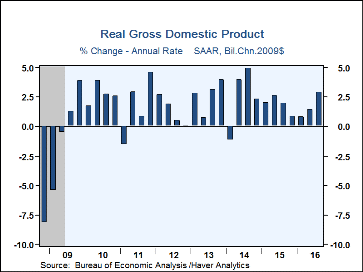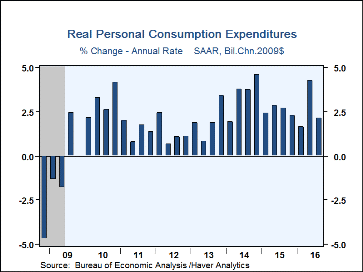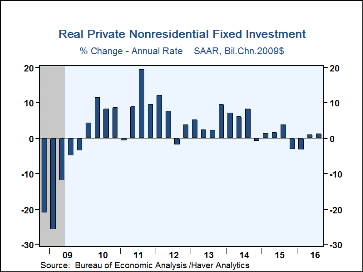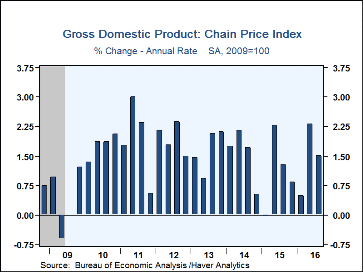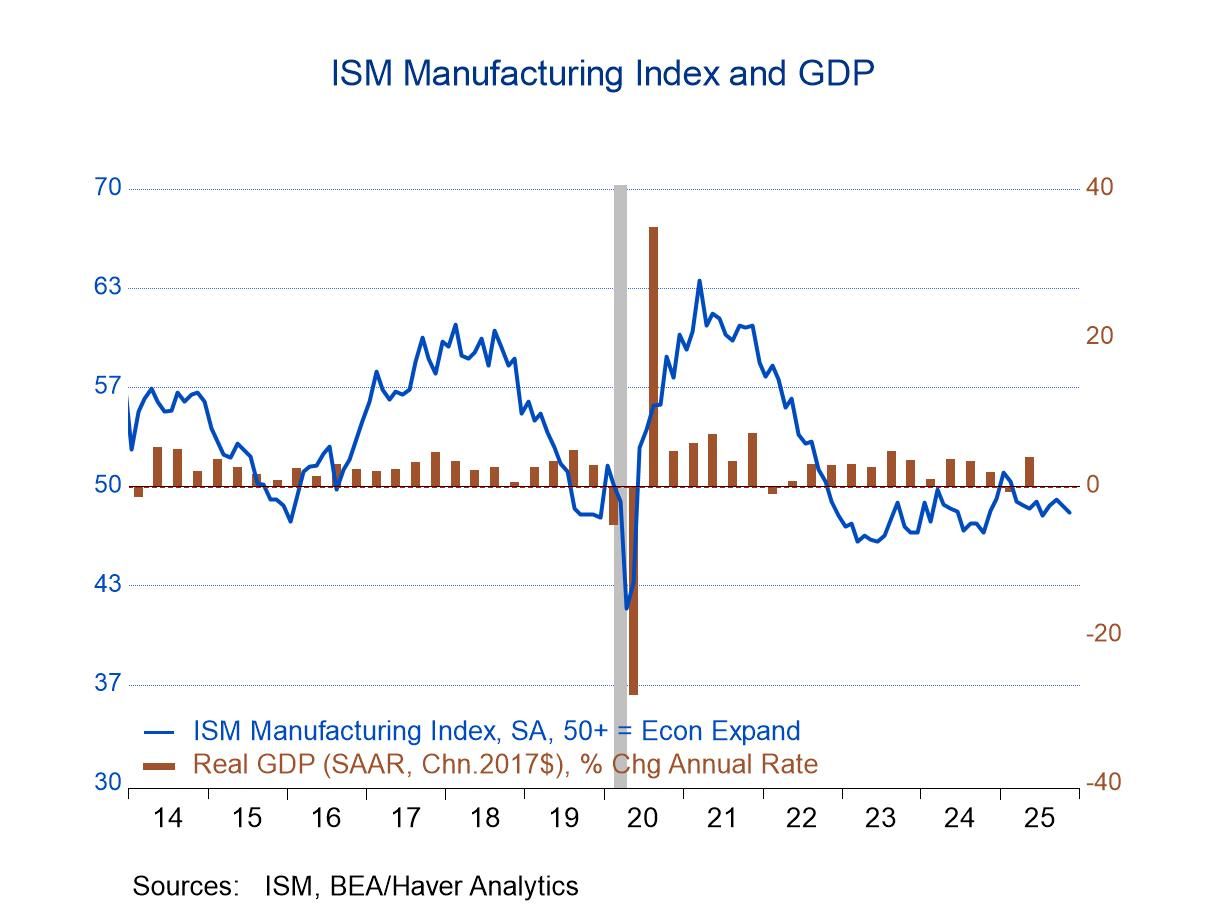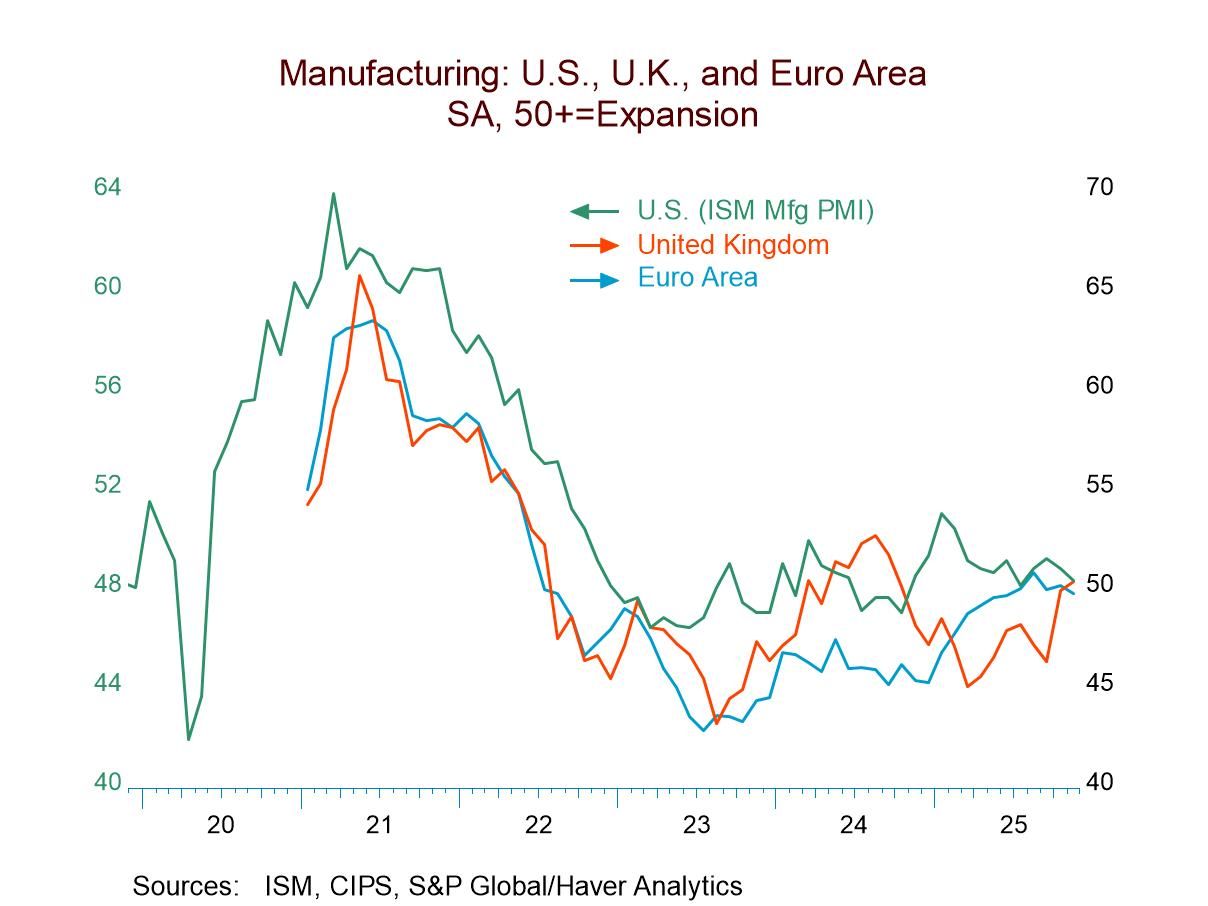 Global| Oct 28 2016
Global| Oct 28 2016U.S. GDP Growth Firms; Exports & Inventories Strengthen
by:Tom Moeller
|in:Economy in Brief
Summary
Economic growth improved to 2.9% (1.5% y/y) during Q3'16 following a 1.4% Q2 rise. It was the strongest increase in two years. A 2.5% rise had been expected in the Action Economic Forecast Survey. Improvement in the foreign trade [...]
Economic growth improved to 2.9% (1.5% y/y) during Q3'16 following a 1.4% Q2 rise. It was the strongest increase in two years. A 2.5% rise had been expected in the Action Economic Forecast Survey.
Improvement in the foreign trade deficit had the largest positive effect on growth. The 0.8 percentage point addition from net exports reflected a 10.0% rise (2.0% y/y) in exports which followed a 1.8% gain. Goods exports rose 14.5% (2.7% y/y) and services exports improved 2.1% (0.7% y/y). Imports increased 2.4% (0.7% y/y), powered by an 8.8% jump (3.2% y/y) in services while goods imports ticked 0.9% higher (0.1% y/y).
Inventories added 0.6 percentage points to economic growth last quarter. That followed five consecutive quarters of subtraction.
Domestic final sales growth decelerated to 1.4% (1.7% y/y) from 2.4%. Growth in personal consumption expenditures fell to 2.1% (2.6% y/y), half the growth in the prior quarter. Durable goods spending advanced 9.5% (5.6% y/y), about as it did in Q2. Motor vehicle spending growth nearly doubled to 16.2% (3.3% y/y. Furniture & appliance spending growth eased to 4.9% (6.3% y/y) and purchases of recreational goods & vehicles fell to 9.0% growth (9.5% y/y). Expenditures on nondurable declined 1.4% (+1.8% y/y) after a 5.7% rise, owing to a 3.5% drop (+0.2% y/y) in gasoline & energy goods purchases. Apparel spending also eased 0.6% (+1.0% y/y), but foods & beverage purchases rose 1.7% (3.0% y/y). Services spending increased 2.1% (2.3% y/y), down from 3.0% in Q2. Housing & utilities spending rose 2.4% (1.4% y/y) after a 4.5% jump, and growth in health care expenditures fell to 2.3% (4.7% y/y) from 7.3%. Restaurant & hotel spending growth picked up slightly to 3.2% (3.0% y/y).
Business fixed investment grew 1.1% (-1.2% y/y) after a similar gain in Q2. These increases followed two quarters of decline. The turnaround reflected 5.4% growth (-3.3% y/y) in structures investment while spending on equipment fell 2.7% (-4.5% y/y), the fourth straight quarter of decline. Transportation equipment investment accounted for the latest drop, off 15.1% (-10.0% y/y), while information processing equipment grew 10.2% (0.7% y/y). Industrial equipment investment also improved 1.1% (4.1% y/y).
Residential investment declined 6.2% (+1.0% y/y), after a 7.8% fall.
Government spending ticked 0.5% higher (0.3% y/y) after a 1.7% drop. National defense spending increased 2.1% (0.0% y/y) following two quarters of decline. Federal nondefense spending grew 3.0% (2.6% y/y) after a 3.8% rise. State & local investment eased 0.7% (-0.1% y/y), the third decline in the last four quarters.
The GDP price index increased 1.5% (1.3% y/y) following a 2.3% rise. A 1.4% advance was expected. The PCE price index rose 1.4% (1.0% y/y) while excluding food & energy, it increased 1.7% (1.7% y/y). The business fixed investment price index grew 0.3% (0.4% y/y) after a 1.2% rise. The residential investment price index increased 5.8% (3.9% y/y), about as it did in Q2.
The GDP figures can be found in Haver's USECON and USNA database. USNA contains virtually all of the Bureau of Economic Analysis' detail in the national accounts, including the integrated economic accounts and the recently added GDP data for U.S. Territories. The Action Economics consensus estimates can be found in AS1REPNA
| Chained 2009 $ (%, AR) | Q3'16 | Q2'16 | Q1'16 | Q3'16 Y/Y | 2015 | 2014 | 2013 |
|---|---|---|---|---|---|---|---|
| Gross Domestic Product | 2.9 | 1.4 | 0.8 | 1.5 | 2.6 | 2.4 | 1.7 |
| Inventory Effect | 0.6 | -1.2 | -0.4 | -0.3 | 0.2 | 0.0 | 0.2 |
| Final Sales | 2.3 | 2.6 | 1.3 | 1.8 | 2.4 | 2.5 | 1.5 |
| Foreign Trade Effect | 0.8 | 0.2 | 0.0 | 0.1 | -0.7 | -0.1 | 0.3 |
| Domestic Final Sales | 1.4 | 2.4 | 1.2 | 1.7 | 3.1 | 2.6 | 1.2 |
| Demand Components | |||||||
| Personal Consumption Expenditures | 2.1 | 4.3 | 1.6 | 2.6 | 3.2 | 2.9 | 1.5 |
| Business Fixed Investment | 1.1 | 1.0 | -3.4 | -1.2 | 2.1 | 6.0 | 3.5 |
| Residential Investment | -6.2 | -7.8 | 7.8 | 1.0 | 11.7 | 3.5 | 11.9 |
| Government Spending | 0.5 | -1.7 | 1.6 | 0.3 | 1.8 | -0.9 | -2.9 |
| Chain-Type Price Index | |||||||
| GDP | 1.5 | 2.3 | 0.5 | 1.3 | 1.1 | 1.8 | 1.6 |
| Personal Consumption Expenditures | 1.4 | 2.0 | 0.3 | 1.0 | 0.3 | 1.5 | 1.3 |
| Less Food/Energy | 1.7 | 1.8 | 2.1 | 1.7 | 1.4 | 1.6 | 1.5 |
Tom Moeller
AuthorMore in Author Profile »Prior to joining Haver Analytics in 2000, Mr. Moeller worked as the Economist at Chancellor Capital Management from 1985 to 1999. There, he developed comprehensive economic forecasts and interpreted economic data for equity and fixed income portfolio managers. Also at Chancellor, Mr. Moeller worked as an equity analyst and was responsible for researching and rating companies in the economically sensitive automobile and housing industries for investment in Chancellor’s equity portfolio. Prior to joining Chancellor, Mr. Moeller was an Economist at Citibank from 1979 to 1984. He also analyzed pricing behavior in the metals industry for the Council on Wage and Price Stability in Washington, D.C. In 1999, Mr. Moeller received the award for most accurate forecast from the Forecasters' Club of New York. From 1990 to 1992 he was President of the New York Association for Business Economists. Mr. Moeller earned an M.B.A. in Finance from Fordham University, where he graduated in 1987. He holds a Bachelor of Arts in Economics from George Washington University.


